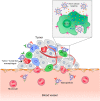Nanoparticles for imaging, sensing, and therapeutic intervention
- PMID: 24641589
- PMCID: PMC4123720
- DOI: 10.1021/nn500962q
Nanoparticles for imaging, sensing, and therapeutic intervention
Abstract
Nanoparticles have the potential to contribute to new modalities in molecular imaging and sensing as well as in therapeutic interventions. In this Nano Focus article, we identify some of the current challenges and knowledge gaps that need to be confronted to accelerate the developments of various applications. Using specific examples, we journey from the characterization of these complex hybrid nanomaterials; continue with surface design and (bio)physicochemical properties, their fate in biological media and cells, and their potential for cancer treatment; and finally reflect on the role of animal models to predict their behavior in humans.
Figures







References
-
- Neel L. Les Proprietes Magnetiques du Sesquioxyde de Fer Rhomboedrique. C. R. Hebd. Seances Acad. Sci. 1949, 228, 64–66.
-
- Bean C. P.; Livingston J. D. Superparamagnetism. J. Appl. Phys. 1959, 30, 120S–129S.
-
- Pankhurst Q. A.; Connolly J.; Jones S. K.; Dobson J. Applications of Magnetic Nanoparticles in Biomedicine. J. Phys. D: Appl. Phys. 2003, 36, R167–R181.
-
- Pankhurst Q. A.; Thanh N. T. K.; Jones S. K.; Dobson J. Progress in Applications of Magnetic Nanoparticles in Biomedicine. J. Phys. D: Appl. Phys. 2009, 42, 224001.
-
- Cullity B. D.Introduction to Magnetic Materials; Addison-Wesley: Reading, MA, 1972.
Publication types
MeSH terms
Substances
Grants and funding
LinkOut - more resources
Full Text Sources
Other Literature Sources

